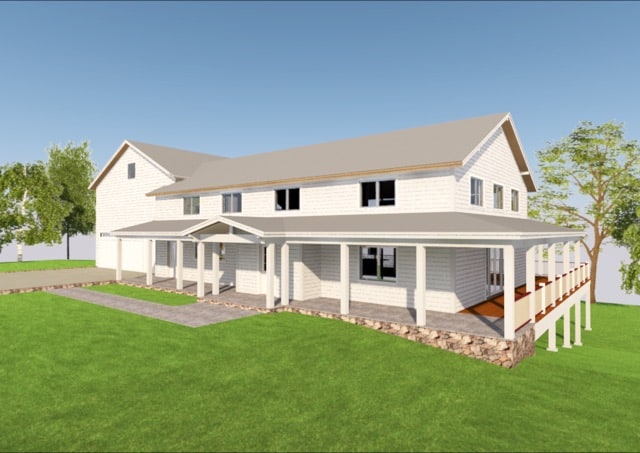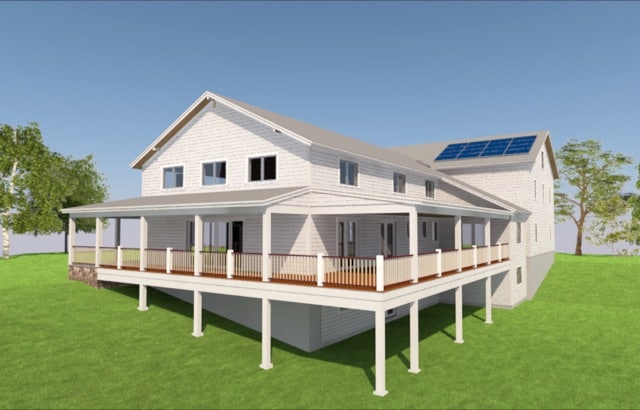My first architecture adventures were in designing and building Solar Greenhouses and Passive Solar Homes. Three decades later, my enthusiasm for eco-friendly design continues. Now, I’m also designing renovations for “aging in place”. At this time in my clients’ lives, they’re thinking ahead to a living on a fixed income. There are a wide spectrum of energy saving moves which can add up to substantial savings. They’re interested in how to save money on energy and live comfortably. Both can be achieved!
How to Save Money on Energy and Live Comfortably
Energy efficient design is an integral part of my design process. When I explore the budget with my clients, I guide the conversation to ways to save money on energy and live comfortably. We’ll examine the heating system for possible upgrades and often choose a high-efficiency gas furnace that will yield benefits immediately in saving money for the owners and will be attractive to future owners.
Then we consider other parts of the equation: products that conserve energy. Better LED lighting can save up to $75 a year. Energy Star appliances can save as much as $2,000 of energy over the lifetime of the appliance (compared to an appliance that was made before 1995). You can program smart thermostats to lower the temperature when you’re not home … which can save $300-$400 a year; that’s more than the cost of the unit.
My focus today is usually on remodeling design. I recommend upgrading the insulation and making your home as airtight as possible. Those are relatively inexpensive things to do and achieve rather quick paybacks. A homeowner can go even further with the insulation by doing a “Deep Energy Retrofit”. This strategy usually involves adding an additional layer of insulation around the outside of a home and triple glazed windows and doors for maximum comfort and energy savings. This is especially attractive if the siding needs to be replaced.
New windows and doors will save energy and eliminate drafts. When we did this at my house, we got an unexpected benefit. My wife and I realized how much quieter the house became with the new windows. When you use low emissivity (Low-E) double glazed windows, it’s more comfortable to sit by the windows, as the inside surface of the glass stays warmer. Triple glazed windows are even better.
The Power of the Sun
Sometimes we have the opportunity to place windows where they will make a difference. In our cold climate, increasing the amount of glass facing south will yield energy benefits. When Myra and I decided to remodel our kitchen, we replaced a wood door and a small window in the pantry with a sliding glass door. That increased the amount of south facing glass from five square feet to 36 square feet in that area. And now we eat lunch in a comfortably sunny area in winter and let the summer breezes in.
Another avenue is rooftop solar. If your home is oriented correctly and if your roof is relatively new, you could consider it. I installed a no-money-down leased system a couple years ago and was able to save money from day one while locking in my energy costs for the term of the lease. My electric bill was cut more than in half. In summer, when the sun delivers the most energy, we can run the A.C. with a ZERO bill from the utility company. (Actually, a small credit)

Residential Sunspaces for Aging in Place
I think back to days when I was building solar greenhouses. In the 1980s, these “sunspaces” were very popular. People loved having a room that provides heat, comfort and a garden. Today, glass rooms and additional windows are still an attractive option when placed properly. A greenhouse solarium I designed for the south side of my parents’ home helped my Grandfather cope with and recover from a serious illness in his eighties. We attached it to his bedroom! A life-long gardener, it allowed him to sit in the sun in and work with his plants year-round. My family believes it extended his life by 3 years. How do you calculate the payback on that investment?
Next Steps
The new International Energy Codes that are just coming into effect are making big changes to the ways we build homes. The insulation and air sealing requirements can no longer be met with the standard methods we have been using. A 2×6 wall with fiberglass insulation, the Gold Standard since the 1980’s, will no longer pass inspection.
If you are planning a new home, consider an even more radical reduction in your Carbon Footprint. My latest project is the design of a new “Net Zero Energy” home or “Passive House” that will produce at least as much energy as it uses. For a modest additional investment in extra insulation, air sealing and better windows, the heating and cooling system can practically be eliminated. A heat recovery ventilation system paired with a high-performance heat pump is all that is needed to provide maximum indoor comfort and healthy fresh air. While the home will be attached to the power grid, a rooftop solar system can provide enough energy to be “net zero energy” on an annual basis. This approach leads to savings of thousands of dollars per year and contributes more value when you decide to sell.
A designer can pay close attention to the sun orientation and conservation to create maximum energy efficiency and maximum comfort. The two go hand in hand.
